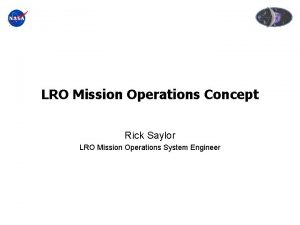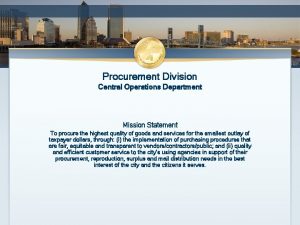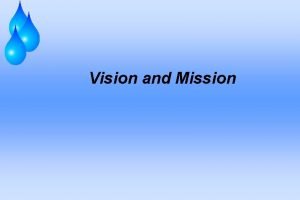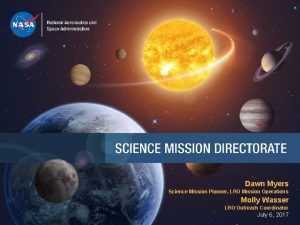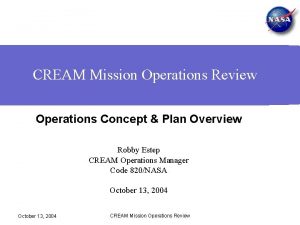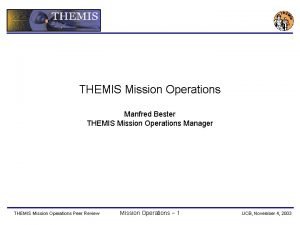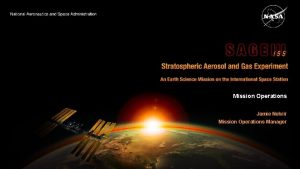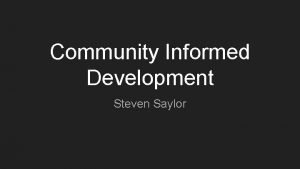LRO Mission Operations Concept Rick Saylor LRO Mission









- Slides: 9

LRO Mission Operations Concept Rick Saylor LRO Mission Operations System Engineer

LRO Mission Timeline NASA’s Goddard Space Flight Center 2

LRO at the Moon • • • NASA’s Goddard Space Flight Center Orbit View Twice a year, LRO will be in full Sun for roughly 1 month (Continuous) Max Lunar Occultation is 48 minutes per orbit Twice a year, LRO will perform a yaw maneuver to keep the Sun on the correct side of the spacecraft Twice a month, LRO’s orbit will be in full view of the Earth for a period of approximately 2 days Once a month, LRO will perform a set of station-keeping maneuvers (combined Delta-V & Delta-H). Maneuvers will interrupt science for 1 orbit each month (~2 hrs). Combined with monthly instrument calibrations Twice a year (on average) the Earth will pass between the Moon and Sun (Lunar Eclipse), interrupting science for approximately 3 orbits – Worse case (~6 hrs) 3

Routine Measurement Timeline NASA’s Goddard Space Flight Center 4

Measurement Operations • Mission Orbit: – 50 km (+/- 20 km) – Approximately 90° lunar equatorial inclination – drifts about 0. 5 °/year – Orbit period: 113 minutes • Orbiter Pointing: – Nadir pointing to control accuracy of 60 arc-sec (3σ) per axis – Pointing stability (3σ per axis): • • 5 arc-sec/axis over 1 ms 10 arc-sec/axis over 100 ms 20 arc-sec/axis over 4 sec LROC observations – Each NAC image takes 15 seconds to fill the camera buffer – Camera buffer is transferred to the spacecraft SSR in approximately 206 seconds – LROC observations include occasional slews • • Slews up to 20 degrees are planned Spacecraft slews are 20 seconds (allow NAC buffer to fill for image). Slew time does not take into account maneuver and settling time. LROC requested 3% of the observations include slews and that the slews are evenly distributed over the year LAMP High Voltage is disabled during Sun-lit portion of the orbit – Remaining instrument components remain powered • CRa. TER peak data rate is 100 kbps during solar flares, during non flare conditions, ~0. 2 bps. NASA’s Goddard Space Flight Center 5

Ground Network Scenario NASA’s Goddard Space Flight Center 6

Ground Network Concepts • S-Band supports scheduled every orbit, each contact is 30 minutes – Requirement to receive ~12 hrs worth of Doppler/Range tracking everyday, 30 minutes every orbit. – S-Band supports will overlap with Ka-Band supports to perform close loop file transfers • Two Ka-Band supports approximately 45 minutes in duration – Over the two contacts, orbiter will dump the previous days worth of measurement collection – Margin is needed for each support to retransmits portions of the data files NASA’s Goddard Space Flight Center 7

Measurement Downlink Concept NASA’s Goddard Space Flight Center 8

On-Board Measurement Storage To MOC (GSFC) NASA’s Goddard Space Flight Center 9
 Rick saylor
Rick saylor Kataoka-yahiro and saylor's model
Kataoka-yahiro and saylor's model Eğitimde program geliştirme modelleri
Eğitimde program geliştirme modelleri Jeff saylor estill county
Jeff saylor estill county Kent saylor
Kent saylor Procurement department mission statement
Procurement department mission statement Ibm vision statement
Ibm vision statement What is the difference between actual self and ideal self?
What is the difference between actual self and ideal self? Perbedaan selling concept dan marketing concept
Perbedaan selling concept dan marketing concept Sweet treats reading pa
Sweet treats reading pa
